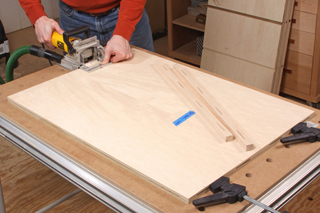
I’ve been doing several projects lately that require a 3/4-inch x 3/4-inch oak banding around the edge of a plywood top. Is there an easier way to fit those and cut them to fit accurately than the “trim-to-fit” approach? – Mike Bellsmith
Tim Inman: If you have enough of it to do to make setting up tooling acceptable, I’d run out a tongue-and-groove system so the oak banding has tongue that seats into a groove cut into the plywood. Perfect fit guaranteed every time. If you don’t have miles of this edging to lay on, you can probably have the job done and over while you’d be setting up and test-fitting your equipment. I’m always amazed at how good, and how fast, the ‘human machine’ can accommodate skill work like this. Learn to use and trust your sense of sight and feel. The results can be amazing – and very satisfying.
Chris Marshall: I’m not completely sure which aspect of the fitting process is causing the most trouble for you, but I’m going to guess that the difficulty is trying to get the banding cut accurately to length so the corners close up nicely around the plywood. I’m also going to presume you are butting the pieces of banding where they meet. Here’s how I would take half of the hassle out of that effort: Leave the length of your plywood panel a little bit longer than necessary, and glue the long side pieces of the banding to it first. Leave those long, too. Then trim the panel to final length. The banding you’ve applied will, of course, line up perfectly with the ends of the plywood because you’ve cut the whole works to length at the same time. Now apply the end pieces of banding to cover the ends of the panel and the glued-on banding. The corner joints should fit perfectly. If you are mitering the ends of the banding instead of butting them, I’m afraid that’s a “trim-to-fit” job for me. It takes care and precision; I don’t know of a faster or more foolproof solution to it. Miter joints are just plain fussy.





